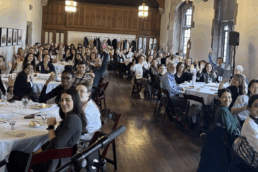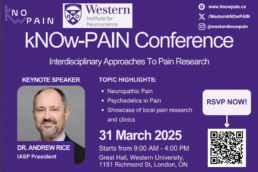From October 19 to 23 2019, the Society for Neuroscience hosted their 49th Annual Meeting in Chicago, IL. It was undoubtedly an important and lively event with 27,832 attendees from 75 countries, 13,677 abstract presentations, and 833 sessions.
This platform provided the opportunity for UTCSP scientists and trainees to showcase their exciting research through poster and oral presentations. The three main nanosymposiums on pain this year were: 1) Pain and Itch Behavior, Circuitry, and Novel Techniques, 2) Pain Imaging and Perception, and 3) New Approaches for Pain Assessment and Treatment. UTCSP trainees were among the speakers of these sessions.
UTCSP trainee and postdoctoral fellow Kathy Halievski (Salter lab) gave a talk at the “Pain and Itch Behavior, Circuitry, and Novel Techniques” nanosymposium on exploring the curious interplay between pain, sex, and the gut microbiota. Specifically, the project aim was to determine whether the microbiota affects acute nociception or hypersensitivity following pain injury in an animal model, and potential sex differences between this interaction. While sex differences were present in certain pain assays, overall, antibiotic-mediated gut microbiota depletion did not affect behavioural responses in acute nociception or in injury-induced hypersensitivity. These findings are important to consider as this field develops, since some, but not all types of pain exhibit an interplay with the gut microbiota.
At the “Pain Imaging and Perception” nanosymposium, UTCSP trainees and graduate students Peter Hung and Sarasa Tohyama (Hodaie lab) gave a talk on advanced structural imaging in patients with trigeminal neuralgia. Hung and colleagues created a machine learning model to predict long-term response to radiosurgical treatment for trigeminal neuralgia from pre-treatment cortical thickness measurements. After cross-validation, the machine learning model predicted long-term response with an 76.5% accuracy. Thus, this brain-based model surpassed prior white matter nerve-level models for this clinical population. These findings hold strong clinical translational potential, as they may help guide treatment decision-making in the clinic.
Tohyama and colleagues identified and defined a new subtype of trigeminal neuralgia, which they termed “lesional trigeminal neuralgia”, using a clinical and neuroimaging approach. They found that patients with this condition are clinically indistinguishable from classical trigeminal neuralgia, but have a single, isolated, plaque-like lesion in the brainstem. Importantly, these patients are refractory to surgical treatment. Thus, the study highlights the important clinical implications of distinguishing this group from other known types of trigeminal neuralgia in the clinic. The study also points to the role of novel treatment strategies, such as neuromodulation, for their management.
Overall, Neuroscience 2019 showcased the great breadth and quality of neuroscience research, and in particular, pain research at the international level. UTCSP members were an integral part of this meeting, which fostered exciting connections, collaborations, and valuable ideas.


